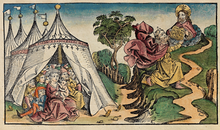

The Horns of Moses are an iconographic convention common in Latin Christianity whereby Moses was commonly presented as having two horns on his head, later replaced by rays of light.[1] The idea comes from a translation, or mis-translation, of a Hebrew term in Jerome's Latin Vulgate Bible, and many later vernacular translations dependent on that. Moses is said to be "horned", or radiant, or glorified, after he sees God who presents him with the tablets of the law in the Book of Exodus. The use of the term "horned" to describe Moses in fact predates Jerome, and can be traced to the Greek Jewish scholar Aquila of Sinope, whose Greek translations were well known to Jerome. The Hebrew qāran' may reflect an allegorical concept of "glorified", or rings of light. Horns tend to have positive associations in the Old Testament, and in ancient middle eastern culture more widely, but are associated with negative forces in the Book of Revelation in the New Testament. These considerations may have influenced the translators in their choices, for Aquila as a positive, or for Jerome, as a negative.
Moses with horns probably first appears in visual depictions in the eleventh century. These portrayals continue to compete with unhorned depictions of Moses through the medieval and Renaissance periods. Many are clearly positive depictions, as a prophet and precursor to Jesus. Other depictions of Moses, horned and unhorned, are likely to have had antisemitic connotations, especially in the later medieval period, for example, on the Hereford Mappa Mundi. Associations between Jews and devils were established, and a belief that Jews possessed horns developed, including through the badges or hats featuring horns they were mandated to wear; it may have been hard for the images of a horned Moses and the "horned" Jew to have been kept apart in the popular imagination. Horned Moses iconography may also have reinforced the idea that Jews have horns.

Michelangelo's horned Moses of c.1513–1515 comes at the end of the tradition of this depiction, and is generally seen as a positive depiction of the prophet, if containing an animalistic or demotic element. Awareness of flaws in the Vulgate translation spread in the later Middle Ages, and by about 1500 it was realized in scholarly circles that "horned" was a mistranslation.[2][3] Horns were often replaced by two bunches of rays of light, springing from the same parts of the head, as seen in the 1481–1482 Moses frescoes in the Sistine Chapel or on the 1544 Mosesbrunnen fountain in Bern, Switzerland. These remained common until the 19th century. Artists often ignored the idea that Moses' rays were given to him when he received the tablets of the law, and by the 19th century some images of the infant Moses in scenes of the Finding of Moses and Moses in the Bullrushes feature the rays.
- ^ Jones 2002, Mellinkoff 1970, p. 238, Blech & Doliner 2008, p. 238, Hoenig 2011, p. 1092, Medjuck 1998, pp. 29–35
- ^ Olszewski 2023, p. 120.
- ^ Exodus chapter 34. William Tyndale, translation into Early Modern English, made c. 1522–1535. Accessed at Bible Study Tools on 18 July 2024.
© MMXXIII Rich X Search. We shall prevail. All rights reserved. Rich X Search
